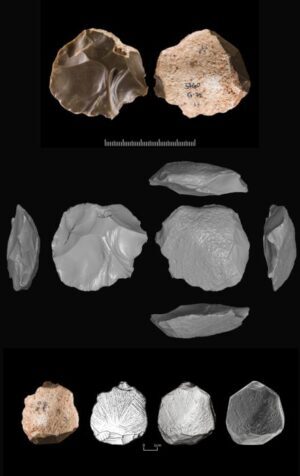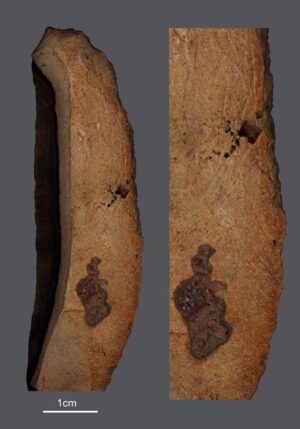
The Hebrew University of Jerusalem—New study demonstrates that certain incised stone artefacts from the Levantine Middle Palaeolithic, specifically from Manot, Qafzeh, and Quneitra caves, were deliberately engraved with geometric patterns, indicating advanced cognitive and symbolic behaviour among early humans. In contrast, artefacts from Amud Cave, with shallow and unpatterned incisions, are consistent with functional use. This research highlights the intentionality behind the engravings, providing key insights into the development of abstract thinking and the cultural complexity of Middle Palaeolithic societies.
_____________________________
A new study led by Dr. Mae Goder-Goldberger (Hebrew University and Ben Gurion University) and Dr. João Marreiros (Monrepos Archaeological Research Centre and Museum for Human Behavioural Evolution, LEIZA, and ICArEHB, University of Algarve), in collaboration with Prof. Erella Hovers (Hebrew University) and Dr. Eduardo Paixão (ICArEHB, University of Algarve), has shed new light on the behavioral complexity of Palaeolithic hominins. Published in Archaeological and Anthropological Sciences, the research* explores the intentionality behind incised stone artifacts, providing compelling evidence of abstract thinking and symbolic behavior during the Middle Palaeolithic period.
Until now, the intentionality of Middle Palaeolithic incised stone artifacts was broadly accepted, although not well-supported by empirical testing. Many archaeologists viewed these marks as functional, created through tool use or natural wear. There was skepticism about the existence of abstract or symbolic thought in early hominins, with the understanding that symbolic behavior, such as art or abstract expression, emerged much later in human evolution and is specifically associated with modern humans. This study challenges that view, offering evidence of deliberate, symbolic engravings prior to global colonization by modern humans.
The study focuses on artifacts from key Levantine sites, including Manot Cave, Amud Cave, Qafzeh Cave, and the open-air site of Quneitra. Using advanced 3D surface analysis, the researchers examined the geometry and patterns of incisions to distinguish intentional engravings from functional marks. The findings reveal striking differences:
Artifacts from Manot, Qafzeh, and Quneitra feature deliberate engravings with geometric patterns that align with the surface topography, underscoring their aesthetic and symbolic intent. In contrast, incisions on artifacts from Amud Cave are shallow, unpatterned, and consistent with functional use as abraders.
____________________________
Advertisement

TAKE A GLORIOUSLY SCENIC WALKING JOURNEY ON ANCIENT ETRUSCAN PATHS FOR THE EXPERIENCE OF A LIFETIME!
____________________________
Dr. Mae Goder-Goldberger explains, “Abstract thinking is a cornerstone of human cognitive evolution. The deliberate engravings found on these artifacts highlight the capacity for symbolic expression and suggest a society with advanced conceptual abilities.”
Dr. João Marreiros added, “The methodology we employed not only highlights the intentional nature of these engravings but also provides for the first time a comparative framework for studying similar artifacts, enriching our understanding of Middle Palaeolithic societies.”
While the engraved artifacts from Qafzeh, Quneitra, and Manot are isolated initiatives within their chronological and geographic contexts, the shared traits of the incisions themselves and the similarities in pattern structuring suggest intentional, predetermined actions. These findings deepen our understanding of symbolic behavior and offer crucial insights into the cognitive and cultural development of early hominins.
This research marks a significant step toward understanding the scope of symbolic behavior of our ancestors, bridging the gap between functional tool use and abstract expression.
_____________________________

The engraved cortical Levallois core of Manot. High-resolution photograph and 3D model. (photo by E. Ostrovsky and drawing by M. Smelansky, 3-D models by E. Paixao and L. Schunk.)
_____________________________

Photo of Amud 1, the retouched blade, note the Incisions on the cortex. (Photo by Erella Hovers)
_____________________________
Article Source: The Hebrew University of Jerusalem news release
*Incised stone artefacts from the Levantine Middle Palaeolithic and human behavioural complexity, Archaeological and Anthropological Sciences, 10-Jan-2025. 10.1007/s12520-024-02111-4
Advertisement




